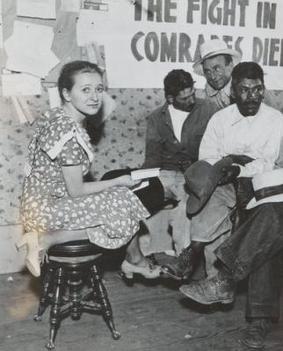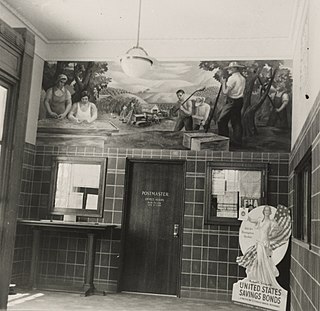Related Research Articles

The United Farm Workers of America, or more commonly just United Farm Workers (UFW), is a labor union for farmworkers in the United States. It originated from the merger of two workers' rights organizations, the Agricultural Workers Organizing Committee (AWOC) led by organizer Larry Itliong, and the National Farm Workers Association (NFWA) led by César Chávez and Dolores Huerta. They became allied and transformed from workers' rights organizations into a union as a result of a series of strikes in 1965, when the mostly Filipino farmworkers of the AWOC in Delano, California, initiated a grape strike, and the NFWA went on strike in support. As a result of the commonality in goals and methods, the NFWA and the AWOC formed the United Farm Workers Organizing Committee on August 22, 1966. This organization was accepted into the AFL–CIO in 1972 and changed its name to the United Farm Workers Union.
The Oxnard strike of 1903 was a labor rights dispute in the southern California coastal city of Oxnard between local landowners and the majority Japanese and Mexican labor force.
In the United States Senate, the La Follette Civil Liberties Committee, or more formally, Committee on Education and Labor, Subcommittee Investigating Violations of Free Speech and the Rights of Labor (1936–1941), began as an inquiry into a National Labor Relations Board (NLRB) investigation of methods used by employers in certain industries to avoid collective bargaining with unions.

The Delano grape strike was a labor strike organized by the Agricultural Workers Organizing Committee (AWOC), a predominantly Filipino and AFL-CIO-sponsored labor organization, against table grape growers in Delano, California to fight against the exploitation of farm workers. The strike began on September 8, 1965, and one week later, the predominantly Mexican National Farmworkers Association (NFWA) joined the cause. In August 1966, the AWOC and the NFWA merged to create the United Farm Workers (UFW) Organizing Committee.

Paul Schuster Taylor was an American progressive agricultural economist. He was an undergraduate at the University of Wisconsin and earned his PhD at the University of California, Berkeley where he then became professor of economics from 1922, until his retirement in 1962.

A farmworker, farmhand or agricultural worker is someone employed for labor in agriculture. In labor law, the term "farmworker" is sometimes used more narrowly, applying only to a hired worker involved in agricultural production, including harvesting, but not to a worker in other on-farm jobs, such as picking fruit.

The Salad Bowl strike was a series of strikes, mass pickets, boycotts and secondary boycotts that began on August 23, 1970 and led to the largest farm worker strike in U.S. history. The strike was led by the United Farm Workers against the International Brotherhood of Teamsters. The Salad Bowl strike was only in part a jurisdictional strike, for many of the actions taken during the event were not strikes. The strike led directly to the passage of the California Agricultural Labor Relations Act in 1975.
The California Agricultural Labor Relations Act (CALRA) is a landmark statute in United States labor law that was enacted by the state of California in 1975, establishing the right to collective bargaining for farmworkers in that state, a first in U.S. history.

Richard Steven Street is an American photographer, historian and journalist of American farmworkers and agricultural issues. He is well known for his multi-volume history of California farmworkers and photo essays.

Caroline Decker Gladstein was a labor activist in the 1930s in California. A member of the Communist Party, as many activists were, she was an organizer for the Cannery and Agricultural Workers’ International Union (CAWIU). Decker helped organize the massive California agricultural strikes of 1933 during the Great Depression.

The California agricultural strikes of 1933 were a series of strikes by mostly Mexican and Filipino agricultural workers throughout the San Joaquin Valley. More than 47,500 workers were involved in the wave of approximately 30 strikes from 1931 to 1941. Twenty-four of the strikes, involving 37,500 union members, were led by the Cannery and Agricultural Workers' Industrial Union (CAWIU). The strikes are grouped together because most of them were organized by the CAWIU. Strike actions began in August among cherry, grape, peach, pear, sugar beet, and tomato workers, and culminated in a number of strikes against cotton growers in the San Joaquin Valley in October. The cotton strikes involved the largest number of workers. Sources vary as to numbers involved in the cotton strikes, with some sources claiming 18,000 workers and others just 12,000 workers, 80% of whom were Mexican.
The Cannery and Agricultural Workers Industrial Union (CAWIU) was a Communist-aligned union active in California in the early 1930s. Organizers provided support to workers in California's fields and canning industry. The Cannery and Agricultural Workers Industrial Union (CAWIU) dated back to 1929 with the formation of the Trade Union Unity League (TUUL). With industrialization and the advent of the factories, labor started migrating into the urban space. An influx of immigrant workers contributed to the environment favorable to big business by increasing the supply of unskilled labor lost to the urban factories. The demand for labor spurred the growers to look to seasonal migrant workers as a viable labor source. Corporations began to look at profits and started to marginalize its workers by providing sub-par wages and working conditions to their seasonal workers. The formation of the Cannery and Agricultural Workers Industrial Union addressed and represented the civil rights of the migrant workers. Ultimately the CAWIU lost the battle, overwhelmed by the combined alliance of growers and the Mexican and state governments. The eventual abandonment of the Trade Union Unity League led to the dissolution of the CAWIU, which later emerged as the United Cannery, Agricultural, Packing, and Allied Workers of America (UCAPAWA).

The Vacaville tree pruners' strike of 1932 was a two-month strike beginning on November 14 by the CAWIU in Vacaville, California, United States. The strikers were protesting a cut in tree pruning wages from $1.40 for an eight-hour workday to $1.25 for a nine-hour workday. The strike was characterized by multiple violent incidents including a break-in at the Vacaville jail that resulted in the kidnapping and abuse of six arrested strike leaders. The strikers were ultimately unsuccessful in demanding higher wages and fewer hours and the CAWIU voted to end the strike on January 20, 1933.
Criminal syndicalism has been defined as a doctrine of criminal acts for political, industrial, and social change. These criminal acts include advocation of crime, sabotage, violence, and other unlawful methods of terrorism. Criminal syndicalism laws were enacted to oppose economic radicalism.
The Salinas California lettuce strike of 1934 ran from August 27 to September 24, 1934, in the Salinas Valley of California. This strike of lettuce cutters and shed workers was begun and largely maintained by the recently formed Filipino Labor Union and came to highlight ethnic discrimination and union repression. Acts of violence from both frustrated workers and vigilante bands threatened the strike's integrity.
The Neutral Thousands, initialized as TNT, was an organization created in 1937 to target union activities and was known as an anti-union organization. The organization rose along with a tide of similar organizations in the period of the late-19th century to the mid-twentieth century. Bessie Ochs, formerly a speaker for the Merchants and Manufacturers Association, was recruited by Byron C. Hanna, the leader of The Southern Californians, Incorporated, to lead the organization. In addition to the general activities of the organization, it also broadcast a radio program, referred to as the "California Caravan".

In 1933 there was a cherry strike in Santa Clara, California. The main overview of the events in Santa Clara was an agricultural strike by cherry pickers against the growers or employers. As the events of the labor strike unfolded, the significance of the strike grew beyond that of the workers themselves into a broader scope within America.
Maria Moreno was an American farmworker and labor organizer. She was the first woman farmworker hired to be a union representative.
Pat Chambers was an influential labor organizer and Communist Party member in the 1930s in California. He was a key figure in some of the largest California agricultural strikes of 1933. Chambers was the inspiration for the character "Mac" in John Steinbeck's 1936 novel, In Dubious Battle.

Farmworkers in the United States have unique demographics, wages, working conditions, organizing, and environmental aspects. According to The National Institute for Occupational Safety & Health in Agricultural Safety, approximately 2,112,626 full-time workers were employed in production agriculture in the US in 2019 and approximately 1.4 to 2.1 million hired crop workers are employed annually on crop farms in the US. A study by the USDA found the average age of a farmworker to be 33. In 2017, the Department of Labor and Statistics found the median wage to be $23,730 a year, or $11.42 per hour.
References
- 1 2 3 4 5 6 Pichardo, Nelson (1995). "The Power Elite and Elite-Driven Countermovements: The Associated Farmers of California during the 1930s". Sociological Forum. 10 (1): 21–49. doi:10.1007/BF02098563. JSTOR 684757. S2CID 144881137.
- 1 2 3 4 5 6 7 8 Starr, Kevin (1996). Endangered Dreams: The Great Depression in California. New York: Oxford University Press. p. 162.
- ↑ Kushner, Sam (1975). The Long Road to Delano. New York: International Publishers. p. 68. ISBN 0-7178-0423-2.
- 1 2 3 Chambers, Clark (1952). California Farm Organizations. Berkeley: University of California Press. pp. 44–45.
- 1 2 3 Violations of Free Speech and Rights of Labor,” Hearings Before a Subcommittee of the Committee on Education and Labor. United States Senate. Part 52. Los Angeles CA, 1940. US Government Printing Office, DC 1940
- 1 2 3 Daniel, Cletus (1981). Bitter Harvest: A History of California Farmworkers, 1870-1941. Berkeley: University of California Press. p. 251.
- ↑ John Steinbeck, "The Grapes of Wrath", Penguin Classics (2006 edition), note 2 to Chapter 22, p. 462.